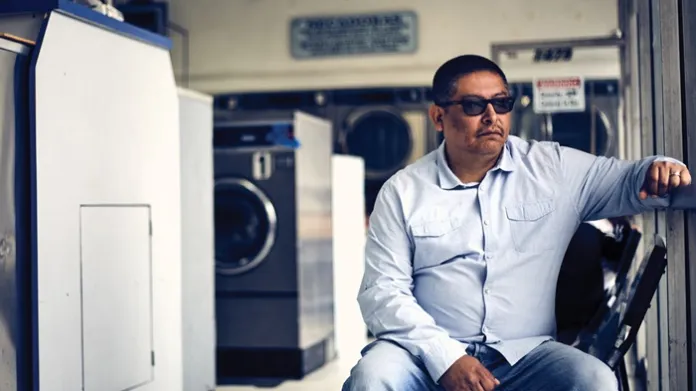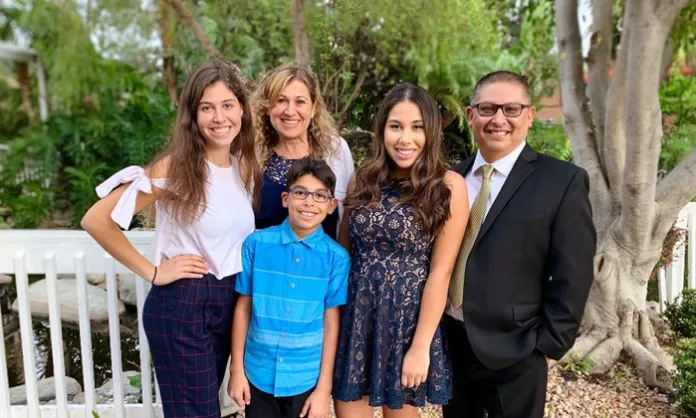It’s easy for a young person to get pulled into the gang life, particularly if there isn’t a strong family unit at home. Casey Diaz joined a gang at an early age and grew to become a notorious gang leader, but the life sent him to prison. Now, he’s helping young people in his community avoid the same fate, having found salvation in Christ Jesus while in prison.
Darwin “Casey” Diaz was once one of California’s most violent criminals. Brought to the United States as a toddler by his Salvadoran parents, he grew up in Los Angeles, California under some difficult home circumstances.
From Hinduism To Preacher of Jesus Christ – Vani Marshall’s Incredible Encounter
Diaz’s father would brutally beat his mother on a constant basis. She would go to work at 4 a.m. only to return home at 10 p.m. to be on the receiving end of another beating.
His mother was at work most of the day, and his father was often drunk, resulting in a lack of parental supervision.
“I think that’s one of things that when a kid doesn’t have a mentor or a father figure that’s a healthy figure to teach him lessons, work ethic, stuff like that, or be part of their life, that really does a big dent in that kid’s life,” Diaz told The Epoch Times.
From Darkness to Light: How Jesus Christ Saved A Buddhist Living In Darkness For Over 30 Years
By age 11, Diaz had joined a gang. In the beginning, the gang provided him with a sense of family. They would pick him up, take him to parties, and hang out. Furthermore, the culture of gangs in the 80s was a big deal in Los Angeles.

One of the gang leaders who was well known took a liking to Diaz, and became a kind of mentor. The leader had a reputation, and was respected and feared by members of his own gang and rival gangs as well.
Man Enters Church With Rifle To Kill Worshippers, But Encounters God
After Diaz’s initiation into the gang, the leader took the 11-year-old Diaz to a rival gang where they jumped a rival gang member and stabbed him with a screwdriver. Diaz quickly found himself in and out of juvenile hall. By age 16, Diaz was arrested and convicted for a gang-related murder.
In prison, I was a shot caller, Casey Diaz recalls.
Shot callers have an elevated rank in the gang world. They are the power-brokers who determine who gets hurt (or killed) and who doesn’t. They command respect.
Over 75% Christians In North Korea Die In Persecution
I started down this path as a teenager in South-Central Los Angeles, as a leader in the Rockwood Street Locos. I led the way when we invaded homes, broke into cars, ransacked convenience stores, and stabbed rival gang members. It didn’t take me long to figure out that the streets were bloody. Most of the time, it was kill or be killed.
From Casting Spells and Channeling Spirits To A Radical Encounter With Jesus Christ
Eventually, the LAPD caught up with me. I was sentenced to nearly 13 years for second-degree murder—along with 52 counts of armed robbery. I actually breathed a sigh of relief that those were the only charges the cops could pin on me.
Life Was Very Cheap
While awaiting transfer to New Folsom State Prison—a Level IV maximum security prison near Sacramento, California—I was housed with 120 murderers and violent criminals inside Pitchess Detention Center, north of Los Angeles.
At Pitchess, we segregated ourselves: blacks aligning with blacks, whites with whites, and Latinos with Latinos. Several dudes from two long-established gangs, 18th Street and Florencia 13, approached me about becoming a shot caller there.
One of my responsibilities was the control and distribution of shanks, the crude homemade knives used for stabbing another prisoner. I slept with all 13 of them under my mattress. When a riot went off, I made sure the right people got shanks. There were many violent upheavals at Pitchess, and inmates got stabbed and killed all the time. All it took was a wrong look at the wrong person, and you were done for. Life was very cheap.
Satanic Temple Demands Satanic Priests Serve as School Chaplains, Threatens Legal Action
After about six months, I was transferred to New Folsom State Prison. When the bus dropped us off at the main building, I saw guards pacing on catwalks, their arms cradling Mini-14s—small, lightweight semi-automatic rifles.
The warden, standing next to a phalanx of serious-looking guards in riot gear, cleared his throat. “I want you to look at the sign to your right,” he said. My eyes alighted on a white sign with red lettering that read, “No Warning Shots Fired.” “In case of a riot,” the warden continued, “we will not be aiming at your feet, we will not be aiming at your legs, and we will not be aiming at your torso. We will be aiming directly at your head to kill you.”
When the warden was gone, a guard approached me with a manila file in hand. “Diaz, follow me,” he ordered. I was led inside the prison to an interview room, where the guard introduced himself as a gang coordinator. “Listen closely, Diaz,” he said. “We know that you’re a banger and a shot caller, so we’re putting you in solitary.”
I would be cooped up in an eight-by-ten-foot windowless box, with all my meals slipped in through a slot in the steel door (or “gate”). Social interactions with other inmates (and guards) would be nearly nonexistent.
The only source of illumination in my cell was a heavy Plexiglas light that couldn’t be turned off, which made it difficult to get any sleep. And without a clock or wristwatch to consult, I had trouble distinguishing whether it was day or night. There was nothing to do—no TV, no radio, no books. Only the meals broke the monotony.
I had been told by prisoners in Pitchess that if you’re not strong-willed, then solitary confinement could absolutely break you. There were times when I wondered if I would keep my sanity.
‘Jesus Is Going to Use You’
After about a year at New Folsom, I heard the guards come by my cell with an announcement: “Protestant service. Any inmate wanting to go, stand by your gate.”
I had heard the same announcement for Catholics. Religion wasn’t something I was interested in. I knew next to nothing about Jesus, only that he was the one on all those crucifixes.
One time I was lying on my bed, listening to the voices outside. I heard an older woman say, “Is there someone in that cell?” She sounded Southern and spoke with a syrupy drawl. “Yes, ma’am,” the guard said, “but you don’t want to deal with Diaz. You’re wasting your time.”
“Well,” she answered, “Jesus came for him, too.”
She approached the cell: “Young man, can I speak with you?” Looking through the open slot in my gate, I couldn’t see anything except for the guard’s boots and a pair of spindly legs.
“How are you doing?” she asked. “I couldn’t be better,” came my sarcastic reply. “Young man,” she said, “I’m going to pray for you. But there’s something else I want to tell you: Jesus is going to use you.”
By now, I was certain she was crazy. Couldn’t she see I was locked away in solitary confinement? “I don’t think that’s going to happen,” I said. But she persisted: “Young man, every time I’m here, I’m going to come by and remind you that Jesus is going to use you.”
A year or so later, I was lying down in my cell, daydreaming, when I turned toward the wall opposite my bed. On that wall, something strange was happening. A movie was playing, a movie about my life. I saw myself as a young child, walking the old neighborhood at 9th and Kenmore. I witnessed incidents from my early days with the gang—everything in picture-perfect detail.
Then I saw a bearded man with long hair carrying a cross. As he trudged along, a mob of angry people shouted at him. When he arrived on top of a knoll, rough-looking men nailed his hands and feet to the wooden beams and raised the cross so it stood between two other men on crosses.

What got to me most was when this man looked at me and said, “Darwin, I’m doing this for you.” I shuddered. Apart from the guards and my family, no one knew my real name. Everyone called me Casey—my nickname for as long as I could remember.
Then I heard the sound of breath leaving him. At that moment, I knew he had died.
That’s when I hit the floor in the middle of the cell. I started weeping because I knew, somehow, that this was Almighty God, even though I didn’t understand what he had done for me. After hitting the floor, I knew I had to get on my knees. I started confessing my sins: God, I’m sorry for stabbing so many people. God, I’m sorry I robbed so many families.
With each new confession, I felt another weight come off my shoulders. When I finished, I knew something major had happened.
I asked to see a chaplain, who opened his Bible and explained who Jesus was and told me that what I experienced in that cell was salvation. He handed me a Bible and urged me to start reading.
I’d spend five or six hours reading that Bible, then fall asleep, wake up, and do some push-ups and calisthenics before picking up where I had left off. I didn’t understand half of what I was reading, but that didn’t bother me.
That was the start of my journey of faith. Eventually, I was released from solitary confinement and returned to the mainline prison population, where I was beaten for being a Christian and turning my back on my fellow gang members. But I was okay with that, because I was no longer a shot caller. I had found a new calling: telling other inmates about Jesus.
As a result of dropping out of the gang, an assassination order was placed on Diaz’s life. In fact, the gang ordered one of Diaz’s own men to take him out.
The hitman approached Diaz’s cell, and the two began talking through a narrow vertical window. The man told Diaz that he had been ordered to “take out the trash,” which meant the gang had instructed him to murder Diaz.
Diaz looked at him and told him that he had played prison politics himself, and knew the man had to do what he had to do. Furthermore, Diaz forgave him for the murder he was about to commit.
“I reminded him that he took orders from me prior to this incident, so I understood fully what needed to happen. But changing my story was not going to happen. I knew that I had encountered Christ, and if it meant me losing my life in here then that’s what needed to happen, and I was okay with that,” Diaz explained.
Diaz prayed the whole night, and by the time morning came the man didn’t have the heart to carry out the hit. Diaz was able to convert the man to Christianity, and was able to convert other gang members as well.
For the following two years, Diaz and his group were constantly attacked. However, after a large prison riot, the people who were after Diaz were sent to other prisons. By the time he was released, he had converted over 200 inmates.
“It’s overwhelming to see lives changed,” Diaz explained.
On July 3, 1995 Diaz was released from the prison at age 24. Diaz is today a pastor, happily married and has a very lovely family.
Casey Diaz is the author of The Shot Caller: A Latino Gangbanger’s Miraculous Escape from a Life of Violence to a New Life in Christ (Thomas Nelson). He lives in Los Angeles, where he owns a sign-making business and serves as a part-time pastor.
Last modified: March 27, 2024





